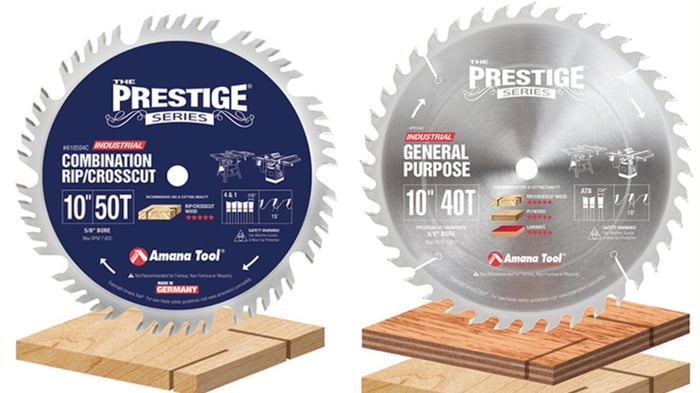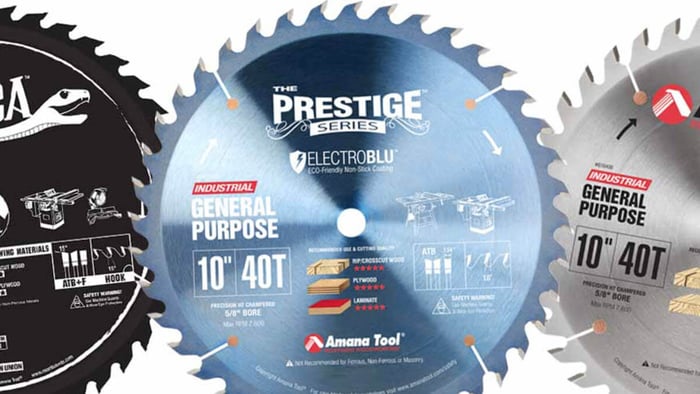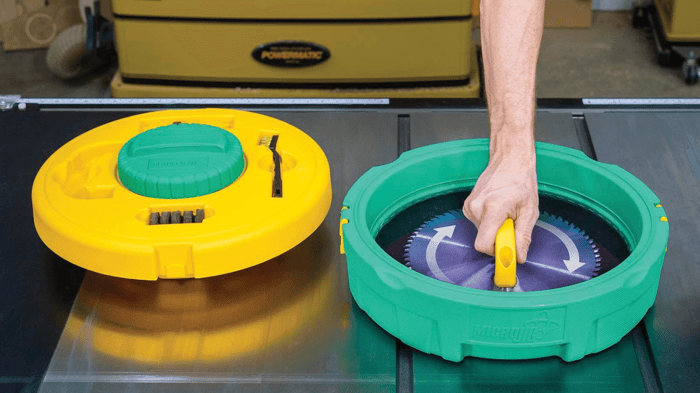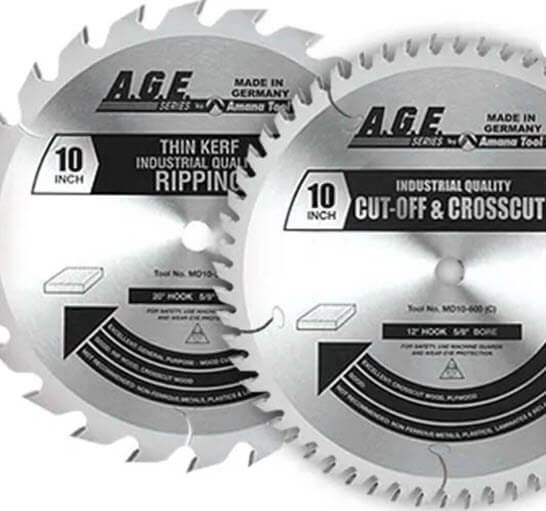
Combination Saw Blades vs. General Purpose
Choosing the right saw blade can significantly impact your woodworking or construction projects. With a variety of options available, it is essential to understand the differences between All Purpose, or Combination saw blades and General Purpose saw blades.
This guide will delve into the unique characteristics, applications, and benefits of each type, assisting you in finding the perfect fit for your specific needs.
Whether you are a professional tradesperson or a DIY enthusiast, having this knowledge will enhance both your cutting efficiency and the overall quality of your work.
Different Types of Saw Blades
In the realm of woodworking, it is fundamental to grasp the various types of saw blades to ensure optimal cutting efficiency and finish quality in your projects.
There is a range of options available, from specialized ripping and cross-cutting blades, combination saw blades and general-purpose blades. Each type comes with its unique features designed to address specific applications, whether you're working with hardwood, softwood, plywood, or non-ferrous materials.
Understanding which saw blade to choose is vital for both DIY enthusiasts and professionals, as it directly impacts the effectiveness of meeting project requirements.

Overview of All Purpose / Combination Saw Blades
If you are to buy just one saw blade, a combination saw blade should be the one to buy. Combination saw blades (a.k.a. "All-Purpose" saw blades) are incredibly versatile tools that excel in various cutting applications, making them a preferred choice for both professional woodworkers and DIY enthusiasts. These blades are specifically designed to deliver balanced performance in both crosscutting and ripping, enabling users to handle a wide array of materials, including hardwood, softwood, and plywood.
What truly distinguishes these blades is their unique tooth configuration, which typically incorporates alternating teeth designed for efficient cutting while minimizing tear-out. The varied top angles not only enhance cutting efficiency but also promote edge retention, ensuring that the blades remain sharp longer, even with regular use.
This durability is essential for any woodworking project, as it reduces the need for constant sharpening or replacement. This allows artisans to concentrate on their creativity rather than maintenance. With the right blade in hand, woodworking tasks can become smoother and more precise, resulting in clean edges and professional-quality finishes.

Combination blades feature the time-tested design of four alternate top bevel teeth with a flat-top raker. The large gullets at the raker tooth allow deep cuts with improved chip ejection.
Uses for All Purpose / Combination Saw Blades
Combination saw blades are highly regarded for their versatility and broad range of applications in woodworking. These blades are essential tools for both DIY enthusiasts and professional woodworkers alike.
Their thoughtful design enables them to function effectively in various tasks, whether it’s crosscutting thick hardwoods or ripping through plywood and laminate. Materials include softwood, hardwood, plywood veneer, solid surface materials, MDF, fiberboard, laminates, melamine, aluminum and other nonferrous metals, plastic, acrylic, lexan, steel, and more.
Common Applications and Benefits
The applications of combination saw blades are quite extensive, addressing a variety of cutting styles that are essential for numerous woodworking projects. Whether one is ripping sheets of plywood or crosscutting hardwood, these blades deliver the efficiency and precision required to achieve high-quality results.
Beyond their primary function in woodworking, these saw blades are also invaluable in industries such as cabinetry and furniture manufacturing, where maintaining a consistent finish quality is crucial. Users have observed that the sharp, durable teeth on these blades cut through a range of materials quickly, which helps to reduce both time and labor costs.
Experts often highlight that the versatility of combination saw blades enables seamless transitions between different cutting tasks, making them a favored option among professionals who seek to optimize their workflow. Feedback from users indicates that these blades not only produce clean cuts but also possess longevity, resulting in fewer replacements and significant cost savings over time.

Overview of General Purpose Saw Blades
General-purpose saw blades are designed to handle a variety of cutting tasks, offering optimal cutting speed and finish quality across different materials. These blades are particularly suitable for individuals who frequently engage in fine woodworking projects, as the precision-ground teeth provide a smoother cut.
By implementing proper sharpening techniques, users can significantly extend the lifespan of their saw blades and enhance their cutting performance. This ensures that both hobbyists and professionals achieve exceptional results in their projects.

General Purpose Prestige™ Saw Blades cut smoother and stay sharper, for longer, in solid wood, plywood, MDF and chipboard. Featuring a massive tool-steel plate (.102" thick!) with expansion slots and copper plugs that practically eliminate vibration. The 40 teeth are ground with a steep 20° bevel angle, alternating left and right, for crisp, clean cuts both across and with the grain. The 18° hook angle yields an effortless feed. The precision-ground D-10 carbide teeth are individually computer-verified to have minimal run-out.
Uses for General Purpose Saw Blades
General-purpose saw blades are well-regarded for their versatility and wide range of applications, making them a dependable option for many woodworking projects.
These blades effectively cut through various materials, allowing both DIY enthusiasts and professionals to achieve excellent results without incurring excessive costs.
Common Applications and Benefits
Common applications of general-purpose saw blades range from simple DIY projects to more intricate professional woodworking tasks, offering benefits that are quite significant. Their consistent performance and durability make them an excellent choice for anyone seeking a dependable cutting solution.
These blades perform exceptionally well across a variety of materials, including hardwoods, softwoods, and even composite materials, which makes them a versatile option for any workshop. By enhancing cutting efficiency, users can complete their projects more quickly without compromising on quality, a factor that is vital in both home and professional settings.
Performance metrics such as cutting speed and edge retention are key features that significantly contribute to user satisfaction. To maximize the lifespan and effectiveness of these saw blades, it is essential to prioritize regular maintenance. This practice not only ensures smoother and more precise cuts but also minimizes the risk of wear and tear on the blades.
Key Differences Between All Purpose / Combination and General Purpose Saw Blades
It is important to understand the key differences between general-purpose blades and combination saw blades when selecting the right tool for your specific needs.
All-purpose / combination blades are designed for versatility, allowing for a range of cutting applications. In contrast, general-purpose blades aim to provide a balanced approach to various cutting tasks. This understanding can significantly impact the outcomes of your projects.
Blade Design and Teeth Configuration
The design of the blade and the configuration of its teeth are crucial factors that significantly influence the performance of combination and general-purpose saw blades. Different tooth configurations can affect cutting angles, cutting speed, and even the quality of the finish achieved in woodworking projects.
For example, blades with alternate top bevel (ATB) teeth are particularly effective for crosscutting, yielding a smoother finish on hardwoods. In contrast, blades featuring flat-top (FT) teeth excel at ripping through softwoods, thereby enhancing cutting efficiency.
Recent advancements in blade technology have introduced features such as carbide-tipped edges and laser-cut expansion slots. These innovations optimize heat dissipation and minimize blade warping during use. Furthermore, advanced coatings enable blades to resist friction and prevent debris buildup, which extends their lifespan and maintains precision.
Such improvements not only meet the increasing standards of the industry but also accommodate a variety of project requirements, ensuring that professionals can consistently achieve superior results.
Material and Cutting Abilities
Material compatibility plays a crucial role when evaluating the cutting capabilities of combination and general-purpose saw blades. It is essential to understand which materials each blade type can effectively handle, whether it be hardwood, softwood, metal, or non-ferrous materials, in order to achieve optimal performance.
Selecting the appropriate saw blade not only improves cutting efficiency but also enhances safety and precision during projects. Each blade features its own distinct design elements that cater to specific tasks, such as tooth count and shape, which directly affect the quality of the cut.
Furthermore, after making the initial selection, it is important to maintain the blade through proper care. Techniques such as inspecting for wear, cleaning after each use, and using the appropriate sharpening tools are vital for keeping blades in excellent condition. This ensures they can consistently handle a variety of materials with outstanding performance.
Choosing the Right Saw Blade for Your Needs
Selecting the appropriate saw blade for your needs is essential for achieving optimal performance and obtaining the desired results in your woodworking projects. It's important to consider factors such as material compatibility, blade thickness, kerf width, and the intended application.
Taking these elements into account can significantly enhance cutting efficiency and improve your overall experience while working.
Factors to Consider
When selecting a saw blade, several factors play a critical role in determining the overall compatibility and performance of your cutting tool. It is essential to prioritize considerations such as blade thickness, kerf width, and safety features to ensure optimal operational use and cutting efficiency.
Understanding cutting angles is vital, as they can directly influence the smoothness of the cut and the type of material being worked with. Additionally, heat dissipation is another crucial aspect; blades that produce excessive heat may become warped or have a reduced lifespan.
Effective vibration control can significantly enhance both precision and comfort during operation, thereby minimizing the risk of fatigue. It is important for users to assess their specific project requirements and budget when choosing a blade, as investing in high-quality tools can lead to improved results and more efficient cuts in the long run.
Frequently Asked Questions
What's the difference between Combination saw blades and General Purpose saw blades?
Both saw blades are designed for general cutting purposes, but there are some key differences between them. The main difference is that an Combination saw blade is designed to cut through a wider range of materials, while a General Purpose saw blade is more specialized for specific materials.
Can I use Combination saw blades for all my cutting needs?
While a Combination saw blade is versatile, it may not be the best option for every cutting task. If you frequently work with a specific material, a General Purpose saw blade may be better suited for that material. Additionally, All Purpose saw blades may not provide the smoothest or most precise cuts compared to specialized ripping or cross-cutting blades.
What materials can I cut with a Combination saw blade?
A Combination saw blade is designed to cut through a variety of materials, including wood, metal, plastic, and even some masonry materials. This makes it a great choice for DIYers or those who work with a variety of materials.
Is a General Purpose saw blade better for precision cutting?
Yes, a General Purpose saw blade is specifically designed for precision cutting. It is ideal for work that requires clean, smooth cuts, such as woodworking or crafting. However, it may not be as effective for cutting through tougher materials like metal or masonry.
Can I interchange a Combination and General Purpose saw blade?
Technically, you can use an All Purpose saw blade in place of a General Purpose one and vice versa. However, keep in mind that each blade is designed for different purposes and may not give you the best results for your specific cutting task.
How do I choose between General Purpose and Combination saw blades?
When selecting a saw blade, consider the materials you will be cutting and the level of precision you need. If you work with a variety of materials and don't require extremely precise cuts, an All Purpose saw blade may be the best choice. However, if you work with specific materials and need precise cuts, a General Purpose saw blade may be the better option.





